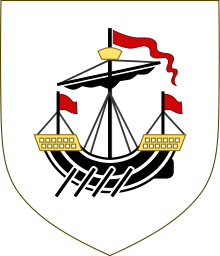
Back Senyor de les Illes Catalan Lord of the Isles German Λόρδος των Νήσων Greek Señor de las Islas Spanish Uharteetako Jaun Basque ارباب جزیرهها Persian Seigneur des Îles French Triath nan Eilean Irish Lord of the Isles ID Signore delle Isole Italian
| Lordship of the Isles | |
|---|---|
 | |
| Creation date | c. 875 AD |
| Present holder | Prince William, Duke of Rothesay |
| Heir apparent | Prince George |


Lord of the Isles or King of the Isles (Scottish Gaelic: Triath nan Eilean or Rìgh Innse Gall; Latin: Dominus Insularum)[1] is a title of Scottish nobility with historical roots that go back beyond the Kingdom of Scotland. It began with Somerled in the 12th century and thereafter the title was held by a series of his descendants, the Norse-Gaelic rulers of the Isle of Man and Argyll and the islands of Scotland in the Middle Ages. They wielded sea-power with fleets of galleys (birlinns). Although they were, at times, nominal vassals of the kings of Norway, Ireland, or Scotland, the island chiefs remained functionally independent for many centuries. Their territory included much of Argyll, the Isles of Arran, Bute, Islay, the Isle of Man, Hebrides (Skye and Ross from 1438), Knoydart, Ardnamurchan, and the Kintyre peninsula. At their height they were the greatest landowners and most powerful lords after the kings of England and Scotland.[2]
The end of the MacDonald Lords came in 1493 when John MacDonald II had his ancestral homeland, estates, and titles seized by King James IV of Scotland. Since that time, the MacDonald Clan had contested the right of James IV to the Lordship of the Isles and uprisings and rebellions against the Scottish monarch were common. More recently, the Lordship of the Isles has been held by the Duke of Rothesay, the eldest son and heir apparent of the King of Scots, a title which, since the creation of the Kingdom of Great Britain, is usually borne by the Prince of Wales. Thus Prince William is the current Lord of the Isles.
Finlaggan on Islay was the seat of the Lords of the Isles under Somerled and Clan Donald.[3]
- ^ "Lord of the Isles". Oxford Reference. Retrieved 19 May 2024.
- ^ At their height the lords of the Isles were thus of comparable power to the Geraldines or perhaps even the O'Neill dynasty of late medieval Ireland.
- ^ "Finlaggan, Islay: The Centre of the Lords of the Isles". Finlaggan Trust. 2015. Retrieved 1 May 2018.
© MMXXIII Rich X Search. We shall prevail. All rights reserved. Rich X Search